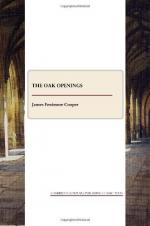The first prairie we had ever seen was on the road between Detroit and Kalamazoo; distant from the latter place only some eight or nine miles. The axe had laid the country open in its neighborhood; but the spot was easily to be recognized by the air of cultivation and age that pervaded it. There was not a stump on it, and the fields were as smooth as any on the plains of Lombardy, and far more fertile, rich as the last are known to be. In a word, the beautiful perfection of that little natural meadow became apparent at once, though seated amid a landscape that was by no means wanting in interest of its own.
We passed the night at the village of Kalamazoo; but the party of females, with old Peter, proceeded on to Prairie Round, as that particular part of the country is called in the dialect of Michigan, it being a corruption of the old French name of la prairie ronde. The Round Meadow does not sound as well as Prairie Round, and the last being quite as clear a term as the other, though a mixture of the two languages, we prefer to use it. Indeed, the word “prairie” may now be said to be adopted into the English; meaning merely a natural instead of an artificial meadow, though one of peculiar and local characteristics. We wrote a note to General Boden, as I found our old acquaintance Ben Boden was universally termed, letting him know I should visit Schoolcraft next day; not wishing to intrude at the moment when that charming family was just reunited after so long a separation.
The next day, accordingly, we got into a “buggy” and went our way. The road was slightly sandy a good part of the twelve miles we had to travel, though it became less so as we drew near to the celebrated prairie. And celebrated, and that by an abler pen than ours, does this remarkable place deserve to be! We found all our expectations concerning it fully realized, and drove through the scene of abundance it presented with an admiration that was not entirely free from awe.
To get an idea of Prairie Round, the reader must imagine an oval plain of some five-and-twenty or thirty thousand acres in extent, of the most surpassing fertility, without an eminence of any sort— almost without an inequality. There are a few small cavities, howevers in which there are springs that form large pools of water that the cattle will drink. This plain, so far as we saw it, is now entirely fenced and cultivated. The fields are large, many containing eighty acres, and some one hundred and sixty; most of them being in wheat. We saw several of this size in that grain. Farm-houses dotted the surface, with barns, and the other accessories of rural life. In the centre of the prairie is an “island” of forest, containing some five or six hundred acres of the noblest native trees we remember ever to have seen. In the centre of this wood is a little lake, circular in shape, and exceeding a quarter of a mile in diameter. The walk in this wood-which is not an Opening, but an old-fashioned virgin forest—we found delightful of a warm summer’s day. One thing that we saw in it was characteristic of the country. Some of the nearest farmers had drawn their manure into it, where it lay in large piles, in order to get it out of the way of doing any mischief. Its effect on the land, it was thought, would be to bring too much straw!




